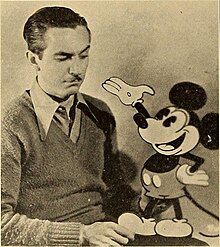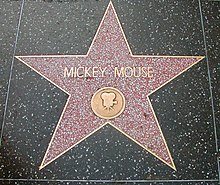Mickey Mouse
The longtime icon and mascot of the Walt Disney Company, Mickey is an anthropomorphic mouse who typically wears red shorts, large shoes, and white gloves.
He is often depicted with a cast of characters including his girlfriend Minnie Mouse, his pet dog Pluto, his best friends Donald Duck and Goofy, and his nemesis Pete.
Inspired by such silent film personalities as Charlie Chaplin and Douglas Fairbanks, Mickey is traditionally characterized as a sympathetic underdog who gets by on pluck and ingenuity in the face of challenges bigger than himself.
[16] After composer Carl W. Stalling initially voiced Mickey for the 1929 talkie shorts The Karnival Kid[17] and Wild Waves, Disney himself provided the often-shy falsetto voice—a large part of the character's onscreen persona.
[22][d] Upon his creation, Mickey's features shared similarities to a number of his cartoon predecessors with large eyes and mouth on a black body[e] (e.g. Oswald and Felix the Cat).
[38] Mickey's eyes were originally large and white with black outlines, with the tops able to deform like eyebrows; the pupil was circular (with a triangle cut out in poster close-ups to simulate reflected light).
[24] During the production of Fantasia in the late 1930s, Fred Moore redesigned Mickey with small white pupilled eyes,[40][41][l] with the redefined facial area being given a light skin color.
It was in response to losing the right to distribute Disney's cartoons that Powers made the deal with Iwerks, who had long harbored a desire to head his own studio.
Similar to his animated inclusion into a live-action film in Roger Rabbit, Mickey made a featured cameo appearance in the 1990 television special The Muppets at Walt Disney World where he met Kermit the Frog.
Animation historian Jim Korkis notes, "After the eighteenth strip, Iwerks left and his inker, Win Smith, continued drawing the gag-a-day format.
"[79] In early 1930, after Iwerks' departure, Disney was at first content to continue scripting the Mickey Mouse comic strip, assigning the art to Win Smith.
Among the characters who had their first comic strip appearances in this story were Clarabelle Cow, Horace Horsecollar, and Black Pete as well as the debuts of corrupted lawyer Sylvester Shyster and Minnie's uncle Mortimer Mouse.
The Death Valley narrative was followed by Mr. Slicker and the Egg Robbers, first printed between September 22 and December 26, 1930, which introduced Marcus Mouse and his wife as Minnie's parents.
Besides Gottfredson artists for the strip over the years included Roman Arambula, Rick Hoover, Manuel Gonzales, Carson Van Osten, Jim Engel, Bill Wright, Ted Thwailes and Daan Jippes; writers included Ted Osborne, Merrill De Maris, Bill Walsh, Dick Shaw, Roy Williams, Del Connell, and Floyd Norman.
In the same period, Romano Scarpa in Italy for the magazine Topolino began to revitalize Mickey in stories that brought back the Phantom Blot and Eega Beeva along with new creations such as the Atomo Bleep-Bleep.
The character is frequently pitted against larger-than-life villains to accentuate this idea; namely the hulking cat Pegleg Pete, and numerous one-shot antagonists such as the giants of Giantland (1933) and Brave Little Tailor (1938), the king of cards in Thru the Mirror (1936) and Mortimer Mouse in Mickey's Rival (1936).
When not facing an opponent, Mickey is oft placed in situations where his pursuits of grandeur or simple accomplishment lead to disastrous results, typically at the hands of his own impulsivity, as was the case in The Sorcerer's Apprentice (1940) among others.
The underdog nature of Mickey's character has been interpreted by historians as a symbolic reflection of Walt Disney's early struggles as a farm boy breaking into the imposing Hollywood industry in the 1920s.
[82] It has also been perceived as an allegory for the Great Depression in the United States, with Mickey's unrelenting optimism symbolizing the "American endurance to survive" in the face of economic woes.
from The Karnival Kid (1929), has endured as a recurring phrase for the character, made especially recognizable to modern audiences for its extensive use in the preschool television program Mickey Mouse Clubhouse.
Alan Young voiced Mickey in the Disneyland record album An Adaptation of Dickens' Christmas Carol, Performed by The Walt Disney Players in 1974.
The game is part of an effort by the Walt Disney Company to re-brand the Mickey Mouse character by moving away from his current squeaky clean image and reintroducing the mischievous side of his personality.
[119] The fictional character Robert Langdon from Dan Brown's novels was said to wear a Mickey Mouse watch as a reminder "to stay young at heart.
In the Comedy Central series South Park, Mickey (voiced by Trey Parker) serves as one of the recurring antagonists, and is depicted as the sadistic, greedy, foul-mouthed boss of the Walt Disney Company, only interested in money.
The full 1991 adaptation of the strip uses a comparatively direct anthropomorphization of Spiegelman, but otherwise continues to use Mickey Mouse imagery to connect contemporary America to the genocide.
In the 1980s, archivist George S. Brown attempted to recreate and sell cels from the 1933 short The Mad Doctor, on the theory that they were in the public domain because Disney had failed to renew the copyright as required by current law.
Oliver then revealed that Last Week Tonight's opening titles had been using an image from Steamboat Willie since the start of the season and that he would begin to use his own version of Mickey Mouse as a mascot of the show.
The animated short, which features the mouse as a kepi-wearing soldier fighting cat enemies in German-style helmets, was viewed by censors as a negative portrayal of Germany.
[165] The Barnyard Battle incident did not incite wider anti-Mickey sentiment in Germany in 1930; however, after Adolf Hitler came to power several years later, the Nazi regime unambiguously propagandized against Disney.
A mid-1930s German newspaper article read: American cartoonist and writer Art Spiegelman would later use this quote on the opening page of the second volume of his graphic novel Maus.










